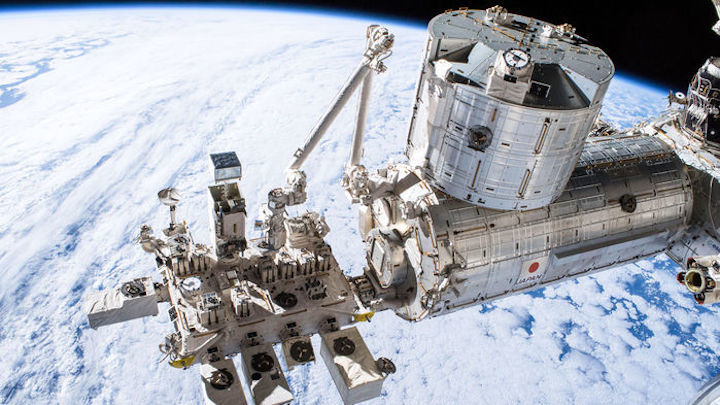3.05.2019

The International Space Station (ISS) has never been known as a hotbed of science, even though the United States and partner nations spent more than $100 billion to build it. Inside its cramped bays, astronauts study the biological effects of microgravity, and a few astrophysical experiments are mounted to its exterior. But 2 decades after it started to take shape, the ISS has finally found a scientific calling: looking down at its home planet.
The ISS is now home to five instruments that observe Earth, with two more set to join this year. One, NASA's Orbiting Carbon Observatory 3 (OCO-3), was scheduled for launch this week from Cape Canaveral, Florida, aboard a routine resupply mission. Its launch marks a political victory: President Donald Trump has proposed canceling OCO-3 several times, only to be rebuffed each time by Congress. It also marks a victory of expedience over perfection.
The ISS is not the ideal platform for OCO-3, which was built to fly on a stand-alone satellite. In fact, "It's probably not the perfect platform for almost anything," says Michael Freilich, who led NASA's earth science division in Washington, D.C. for 12 years until his retirement in February. "It's big. It flexes. It travels around in a cloud of contaminants." And, most important, its orbit misses the poles and revisits sites at a different time each day. But compared with launching a satellite, mounting the instrument on the ISS is vastly cheaper: At $110 million, OCO-3 costs a quarter as much as OCO-2, which launched as a stand-alone mission in 2014.
The savings have helped NASA preserve the breadth of its earth science missions, after two spectacular launch failures: the loss of the original OCO satellite, which crashed into the Indian Ocean in 2009, and the 2011 demise of Glory, meant to track atmospheric particles. Although Freilich marshaled support to build OCO-2, costs doubled for several other planned satellites, putting smaller missions in jeopardy.
Around this time, Japan added a module to the ISS. Its flat terrace, jutting off its human-habitable module, was a good perch for 10 plug-and-play instruments. If putting Earth-observing instruments there would let NASA get much of the science for a fraction of the cost, that seemed like a good deal, Freilich says. "Everybody benefits. [NASA's human program] gets to show the utility of the station," while the earth science division flies more experiments.
OCO-3 will be the third prominent NASA mission to be mounted on the Japanese module within the past year. Ecostress, attached in July 2018, measures the heat given off by plants to gauge the impact of heat waves and drought. The Global Ecosystem Dynamics Investigation (GEDI), launched in December 2018, uses a laser to probe the height of tree canopies and understories. Later this year, a Japanese hyperspectral imager that can detect land use and forest type will take a fourth spot. Other instruments mounted elsewhere on the ISS in the past 2 years measure lightning, incoming sunlight, and ozone.
Like OCO-2, OCO-3 carries a spectrometer that spies on wavelengths of light absorbed by carbon dioxide (CO2), providing a count of all CO2 molecules on a path from the ISS to the surface. Based on how CO2 concentrations vary from place to place, the missions can map some emission sources along with absorption by plants. But the measurements are difficult given the vast background of CO2 already in the atmosphere.
At first the OCO-3 team wasn't thrilled to end up on the ISS, says Annmarie Eldering, the mission's project scientist at the Jet Propulsion Laboratory (JPL) in Pasadena, California. But they came to see advantages. The erratic timing of its observations will make it challenging for OCO-3 to infer trends over weeks or months but will allow the instrument to explore how plant carbon emissions vary over the course of the day. "That's going to be very useful," Eldering says, especially when combined with measurements taken simultaneously by GEDI and Ecostress.
OCO-3's angled perch on the ISS also required a pivoting mount to allow it to see straight down. By pivoting, it can map CO2 over large regions, roughly the size of the Los Angeles, California, basin, during a single pass. Such regional maps could capture emissions from local sources such as cities and industry, says Christopher O'Dell, an atmospheric scientist at Colorado State University in Fort Collins, and enable OCO-3 to test the promise of verifying CO2 cuts from space. "That's the goal," O'Dell says. "We don't know if that's possible."
The ISS has one key constraint: space. After 3 years, OCO-3 is likely to be displaced on the Japanese module. NASA and Japan are already talking about what will go next to take its slot, Eldering says. Afterward, she says, "They will take us off and burn us up in the atmosphere."
Yet the promise of a space-based platform for making multiple simultaneous measurements of Earth at lower cost will live on. Rudranarayan Mukherjee, a JPL engineer, is developing a concept called the Science Station: a robotic mini–space station with trusses and a robotic arm that could host a dozen Earth-observing instruments in low orbit. The space station, he says, "has shown the benefit of having a platform in lower Earth orbit that's a shared resource." NASA hasn't yet committed to the concept, he says. But he adds, "People can instantly see, yeah, I could see how that could work."
Quelle: AAAS
